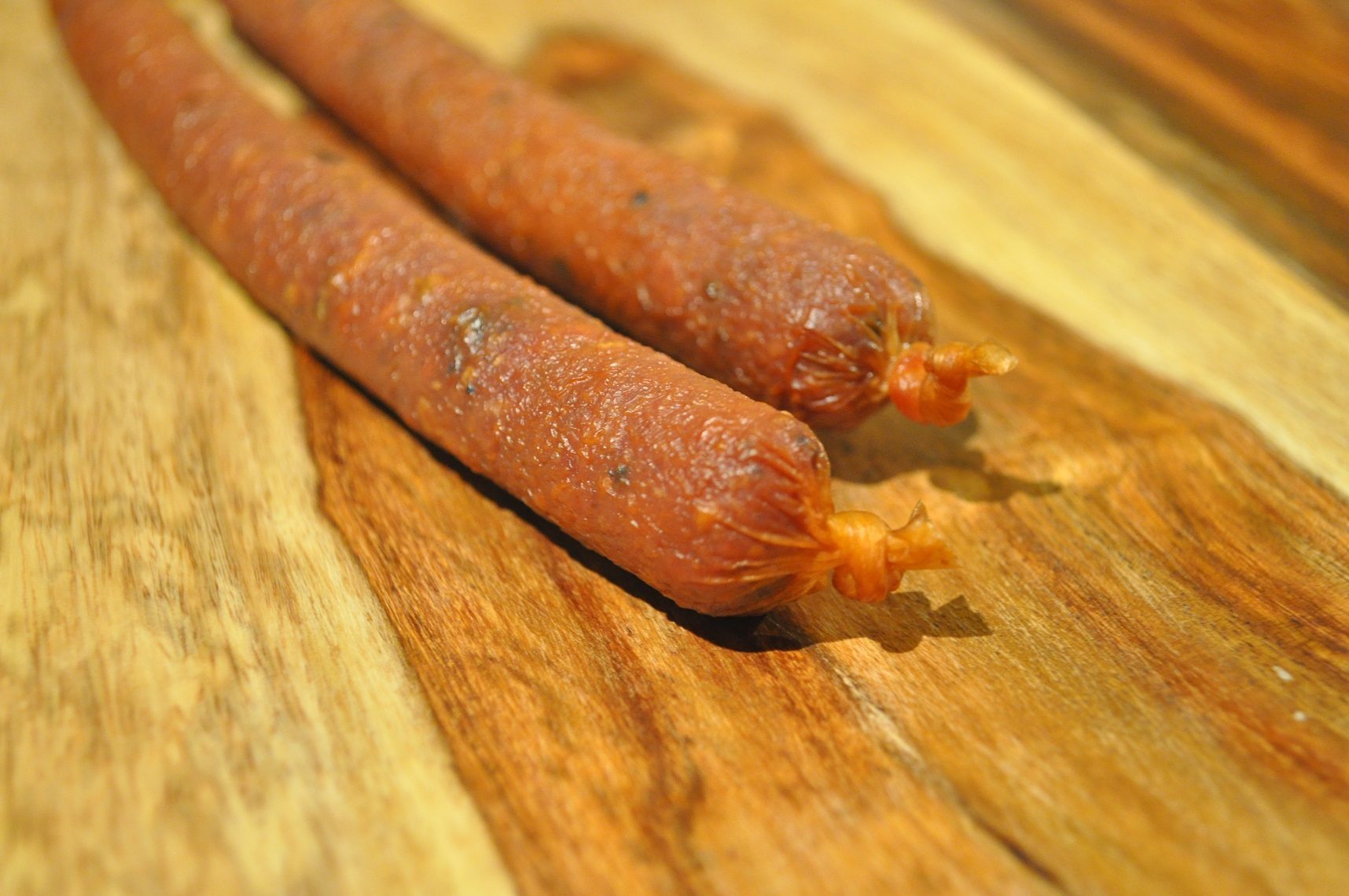Curing sausages and meats can be a daunting task, but it is incredibly rewarding. Besides, the end result is worlds above any store-bought product you can find. True, there are some techniques you will have to master to safely produce a quality cured meat or sausage. But with modern technology and curing products it can be surprisingly simple.
Pepperoni is a type of sausage traditionally made from finely ground cured pork & beef that is lightly smoked. It is stuffed in thin collagen casing and gets its characteristic red colour from: paprika & cayenne, and the curing reaction of sodium nitrite.
Constant Control of Humidity and Temperature
You can buy an expensive curing chamber to regulate temperature and humidity throughout the process. Or you can take the DIY route and retrofit a used fridge!
I bought a used mini fridge that already had temperature control, of course. As I didn’t want to drill a hole through the door of the fridge to get a humidifier inside; I cut a thin piece of the rubber from the edge of the door seal to feed a cord through.
I placed a cool humidifier and a thermometer-hygrometer (measures temperature and relative humidity) inside the fridge and brought it to the specifications I needed.
You need to regularly check on the environment in the mini fridge. Sometimes to raise/lower temperature, others to turn on/off the humidifier to maintain a desired environment. If you are more technically inclined, you can make it more automated than I did. But my little fridge was inexpensive and effective nonetheless.
Making, Fermentation, Smoking and Drying – the Four Steps
When curing sausage you will do through four main steps:
- making the sausage itself
- fermentation
- smoking
- and drying.
Making the sausage itself is simple enough. Here you will add all of your seasonings, culture and cure to the meat. The key, as always, is to ensure that you maintain a sterile and cool environment throughout production.
Wash your equipment prior to use and throw it all in the freezer while preparing and measuring spices. Then you can grind, mix and stuff in record time, reducing the exposure to any harmful bacteria.
Check Culture’s Specification Sheet For Proportions and Fermentation Conditions
Fermentation is where the bacterial culture you’ve add gets to do its thing. Inoculating with good bacteria ensures that the bad bacteria can’t take over and spoil the meat, as it becomes the dominant bacteria in the sausage.
Essentially if the good guys take up all the space, there’s no more room in a sausage for the bad guys. The good bacteria feed on the sugars added to the sausage and multiply under the correct controlled conditions that are specific to the culture added.
So if you chose to use a different culture (such as TSP-X) remember to consult the culture’s specification sheet for proportions and fermentation conditions.
Cold smoking adds flavour to the sausage and helps preserve the product, but it is not fully preserved until it is partially dried thereafter.
The final step is to dry the sausage. Once again in a controlled environment that is cool and dark to so the moisture will be pulled out of the sausage. Bacteria are drawn to and multiply in moisture. Therefore, to ensure that your product will be preserved and that bacteria won’t spoil it, you have to remove as much water as possible.
Cure #1 or Cure #2? Know he Difference
Now an important point is the need for cure in smoked and/or dried sausage. There are two different types of cures conveniently named Cure #1 and Cure #2.
Cure #1 is the short-term cure which contains nitrites (either sodium or potassium bound) and Cure #2 is the long-term cure which contains nitrates (either sodium or potassium bound) that over time breakdown into nitrites.
Nitrites prevent growth of botulism bacteria which thrive between 40-140°F. This temperature range is where the sausage will be during the last three steps of the pepperoni making process. This is crucial for this bacterium not to multiply within the pepperoni.
Regardless of all the good bacteria we add, the smoking and the drying botulism bacteria can still take hold. Reason why nitrite cures are so important. Never cold smoke and dry sausage without it!
Still Up to it? Get your Hands on
Now with all the rules and warnings laid out, I hope you’re still keen to give pepperoni making a try. When you follow the steps and be mindful of what you’re doing, you’ll see that it’s a fun and easy process.
Ingredients
2 lbs pork shoulder
0.84 lbs beef (I used stew cuts)
36 g salt
3.2 g Cure #2
2.5 g Dextrose 0.2%
4 g sugar
8 g paprika
3 g cayenne
3 g anise seeds
2 g fennel seeds
0.8 g Mondostart 2 M culture
Directions
1. Cube and then finely grind pork & beef together
2. Weight out remaining ingredients and mix together
3. Mix together with meat until well combined (2-3 minutes in a stand mixer on low speed should do the trick)
4. Stuff into collagen casings
5. Ferment at 71 F for 72 hours, 85-90% humidity
6. Cold smoke for 8 hours with hickory bisquettes
7. Dry at 54-6 0F, 80-85% humidity, for 5-7 weeks (dry until you observe a weight loss of 30%)
8. Store in a cool dry place (less than 60°F)





